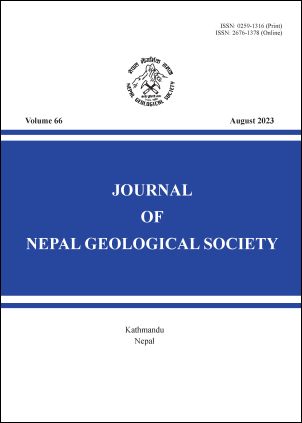Tectono-lithostratigraphy of the outer Lesser Himalaya in the Barahakshetra-Tribeni area, Arun valley section, eastern Nepal
DOI:
https://doi.org/10.3126/jngs.v66i01.57955Keywords:
Lesser Himalaya, east Nepal, tectono-lithostratigraphy, Gondwana, diamictiteAbstract
Geological mapping was carried out in the outer part of the Lesser Himalaya in the Barahakshetra – Tribeni area of east Nepal along the Arun River valley. A revised and updated tectono-lithostratigraphic scheme of the area along with detailed description of each unit and their comparison with central and west Nepal has been presented in this work. The area is divided into three tectonic units named as the Chimra Thrust Sheet, the Dharapani Thrust Sheet and the Tribeni Paraautochthon from north to south, respectively, separated by the Chimra Thrust and the Dharapani Thrust. The rocks of the Chimra Thrust Sheet consist the Pre-Cambrian Phongsawa Group and is divided into the Mulghat Formation, Okhre Formation, Jyamire Gneiss and Belhara Formation, from bottom to top, respectively. The Jyamire Gneiss is comparable to the Ulleri Augen Gneiss and other formations are equivalent to the lower part of the Kuncha Formation. The Dharapani Thrust Sheet, comprising Pre-Cambrian Bhendetar Group, is subdivided into the Chiuribas Formation, Sangure Quartzite and Karkichhap Formation, from bottom to top, comparable with the upper part of the Kuncha Formation, Fagfog Quartzite and Dandagaon Phyllite, respectively. The Tribeni Paraautochthon is divided into the Late Pre-Cambrian Lukuwa Dolomite unconformably overlain by the Gondwana and post-Gondwana rocks of the Barahakshetra Group. The Barahakshetra Group is divided into the Kokaha Diamictite and Baraha Volcanics, Sapt Koshi Formation and Tamrang Formation, from bottom to top, comparable with the Sisne Formation, Taltung Formation and the Dumri Formation, respectively.
Downloads
Downloads
Published
How to Cite
Issue
Section
License
© Nepal Geological Society




